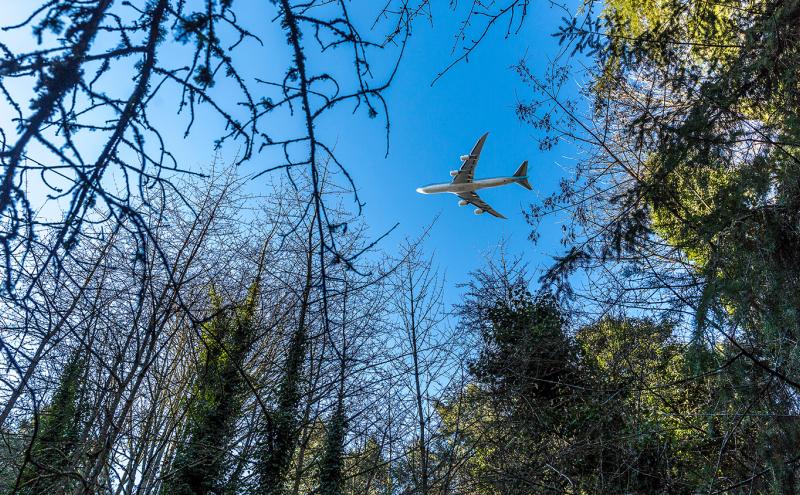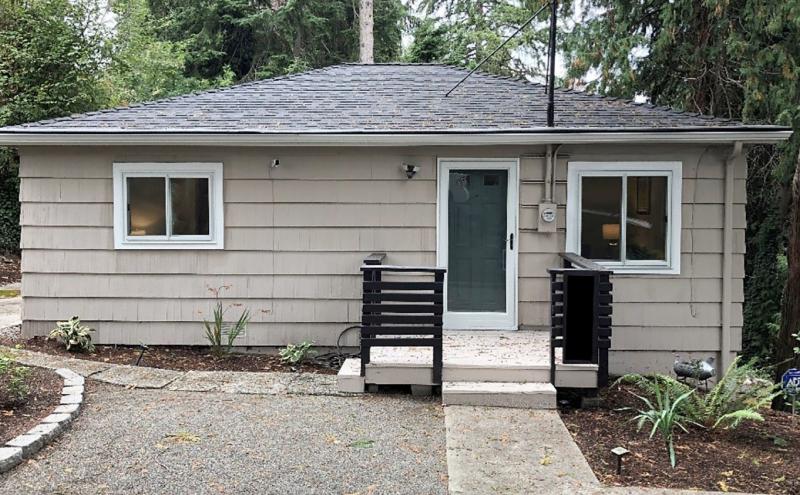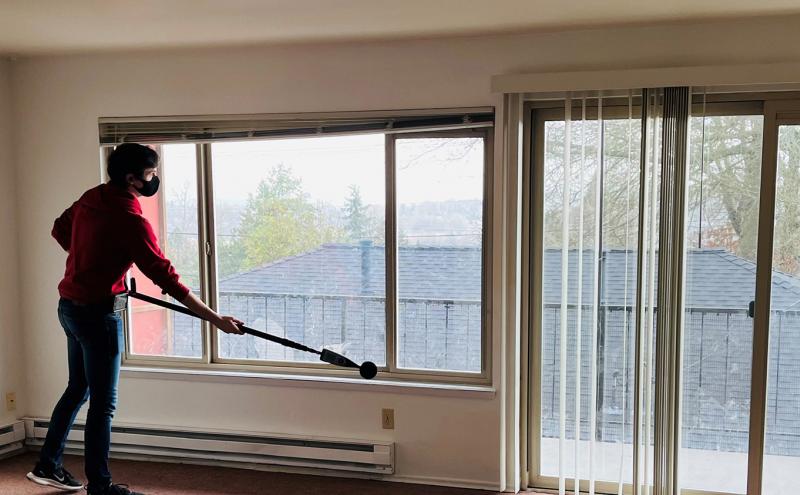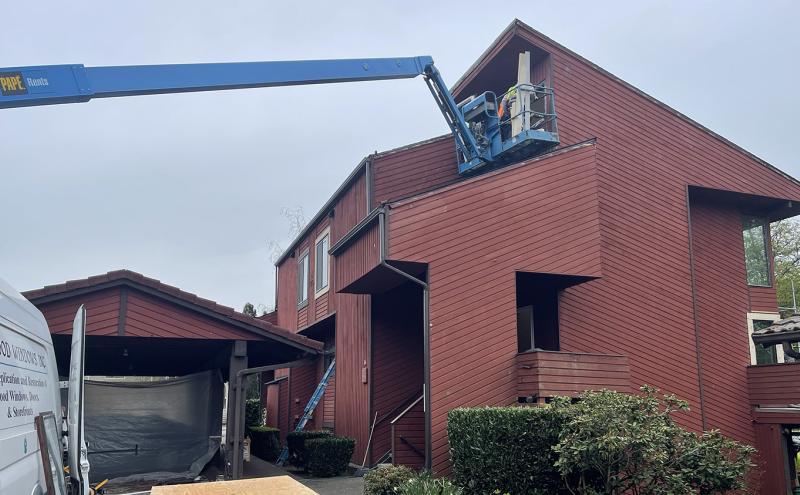
Pat has lived in her Des Moines condo for the past 30 years. Her condominium development, the 28-unit Villa Enzian, is located south of Seattle-Tacoma International Airport’s (SEA) third runway. From her deck, she can look up at airplanes as they take off and land. As a retired travel industry professional, its close proximity to the airport suited her lifestyle and love of travel.
Pat didn’t initially mind the noise associated with living close to an airport. But over time, stopping conversations midsentence or closing windows as airplanes flew overhead became part of the drill.
The Villa Enzian is located within the noise remedy boundary for SEA Airport as defined by the Federal Aviation Administration (FAA). That means Pat and her neighbors qualified to receive assistance from the Port of Seattle’s Sound Insulation Program, launched in 1985 to reduce noise impact in communities surrounding the airport. As part of the program, the Port studies noise levels and publishes publicly available noise exposure maps identifying those levels within the noise remedy boundary. The program also -mitigates improvements to eligible residences within the noise remedy boundary. Pat signed up for those improvements and, in her words, the results have been “tremendous”.
Installing noise insulation
To date, the Port’s Sound Insulation Program has completed nearly $300 million in noise reduction improvements for communities surrounding the airport. Sound insulation near the airport is typically funded with approximately 80% in grants from the Federal Aviation Administration (FAA) and 20% from SEA Airport revenues.
Since 2019 the Port has secured more than $35 million in FAA Airport Improvement Program (AIP) funding, including $21 million for noise insulation.
Completed work includes:
- Installation of sound insulation in over 9,400 single-family homes since 1985
- Sound insulation in 274 condo units in six complexes
- Investments of $100 million for sound insulation ($50 million from the Port and $50 million from the FAA) in noise-impacted school buildings. Ten of 15 identified schools are complete.
- Expenditures of $14 million for sound insulation in 14 Highline College buildings
To date, almost all eligible single-family homes within the noise remedy boundary have been insulated. The program is currently focused on apartments, places of worship, completion of current condominium projects, remaining interested single-family homes, and buildings and residential units in construction or design phases.
In July 2023, the Port of Seattle Commission authorized the latest phase of its Sound Insulation Program (SIP), with a focus on eligible apartments within the current noise remedy boundary around SEA Airport.
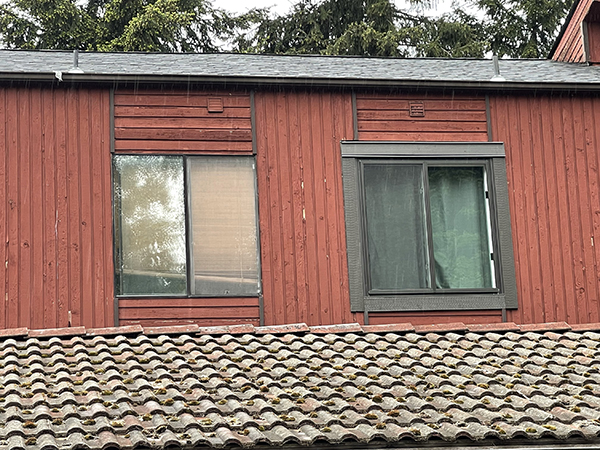
Improved quality of life
At first, Pat was hesitant to have sound insulation installed because she was afraid of the disruption to her life. Once she took the plunge in May 2023, she was pleased that the work was completed in just two weeks. Staff worked efficiently and unobtrusively and were respectful of property.
The difference since the insulation was installed has been “tremendous,” she said.
“Just after it was completed, a friend was visiting who had been in my place before sound insulation had been installed. She told me the difference was remarkable; the noise has been abated and I’m completely satisfied,” she said. “It’s no longer annoying; it doesn’t impact conversation.”
Pat’s neighbors in the Villa Enzian are also pleased with their sound insulation and say the value of their property has increased. And she is also pleasantly surprised by how attractive the new windows are. “They lighten up the interior,” she said. “This winter I’m quite certain it will make a difference to improve the feeling of lightness.”
Kyoko’s home in Burien is inside the noise remedy boundary and was built in 1962 before local building codes required the use of building materials to reduce interior noise. So her home was eligible to participate in the program. She purchased her home in 2017 and encountered challenges from the noise from airplanes using the airport.
Since the Port installed sound insulation in the summer of 2022, Kyoko can hardly hear any noise from airplanes flying over. She is now able to watch television, have conversations with friends, and conduct video conference calls as she works from home without interruptions. The sound insulation has another added bonus. The new windows and insulation hold in the heat better and keep her house warmer, reducing the air leaks through the outer walls, windows, doors, and other openings.
More peaceful worship
The Port took an important next step this week to provide $25.9 million in funding to expand noise mitigation to places of worship that fall within the SEA noise remedy boundary. The Port also received $6.25 million in FAA Airport Improvement Program (AIP) grant funding for places of worship. Three places of worship are eligible and participating in the Port’s Sound Insulation Program with work to be completed by the end of 2026.
Construction work will include the installation of :
- Sound-rated windows and exterior doors
- Storm doors
- Ventilation systems to keep air flowing through newly sealed spaces
- Removal of hazardous building materials
The Port has established goals for federally-certified Disadvantaged Business Enterprise (DBE) consultants and contracts to support the program.
Do you qualify?
Qualifying and completing work through the Sound Insulation Program is a multi-step process that includes pre-testing, owner documentation, and professional design services to develop tailored noise reduction plans for individual properties before construction begins. The program team of specially-trained architects, engineers, construction managers, and acoustic specialists work together to plan and complete the sound insulation improvements.
For a home to be considered for the Sound Insulation Program, it must meet the following criteria:
- Located within the current noise remedy boundary established under the Federal Aviation Administration (FAA) accepted Noise Exposure Map (NEM)
- Built before 1986 or 1987 (depending on the jurisdiction)
- An average interior noise level that is 45 dB DNL or greater in habitable rooms with the windows and doors closed (as determined during acoustic testing)

